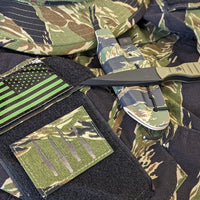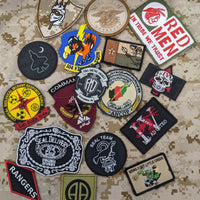From the early days of warfare to modern-day combat, helmets have been an essential part of a soldier's kit. Over time, these protective headgear have evolved drastically in terms of design and functionality - from traditional steel pots to high cut ballistic helmets with advanced features like night vision capabilities. In this blog post, we'll explore how manufacturers have adapted to meet the changing needs of soldiers over time, including the emergence of fast helmet setups.
Historical Overview: From Traditional High Cut to Modern Innovations
The transition to high cut style helmets, like Opscore and Team Wendy, have become increasingly prevalent in recent years. However, it is important to recognize that high cut helmets have a rich history predating their current popularity. The roots of this helmet design can be traced back to the pioneering work of RBR in England, specifically with their F6 MACH 3 helmet.
As one of the earliest traditional high cut designs, the RBR MACH 3 laid the groundwork for subsequent companies to explore and refine the concept. Its impact cannot be overstated, as it set the stage for the development of modern high cut helmets that offer enhanced functionality and protection. Thus, while the current trend towards high cut helmets may seem novel, it is rooted in a historical lineage of innovation and advancement in headgear design.

The Rise of High Cut Helmets: Opscore and Team Wendy Leading the Way
Opscore and Team Wendy are two companies leading the way in high cut helmet development. Opscore's High Cut Ballistic Helmet is designed for maximum protection and comfort, while Team Wendy's EXFIL Ballistic Helmet offers comparable protection and preferred comfort.
Both of these helmets are currently in use by special forces units around the world, and are quickly becoming the standard for front line troops as well. With their advanced design and superior protection, it's clear that high cut helmets are here to stay.
MICH Series: Comfort and Communication Advancements in Helmet Design
The MICH series (Modular Integrated Communications Helmet) of helmets is designed for maximum comfort and communication capabilities. These helmets are made to be lightweight compared to the previous generation of helmets and offer superior protection against ballistic and fragmentation threats. They also feature larger ear cuts for improved comfort while wearing communications equipment. The MICH series represents a timeless helmet design and provides soldiers with the best possible protection.

Lightweight Solutions: Non-Ballistic Helmets
As the world of military helmet technology has progressed, so has the need for lighter weight solutions. With the increasing use of body armor and other protective gear, soldiers are carrying more weight than ever before. This has led to a demand for lighter weight helmets that can provide the same level of protection as their heavier counterparts.
One such solution is the non-ballistic helmet typically coined as a "Bump". These helmets are designed to protect the wearer from impact injuries, but not from bullets or other ballistic threats. They are often made from lightweight materials such as Reinforced Polymer or carbon composites, and can be significantly lighter than traditional ballistic helmets.

Balancing Protection and Comfort: The Resurgence of Mid-Cut Helmets
The mid-cut helmet is making a comeback in the military world. This type of helmet offers a balance of protection and comfort. The mid-cut has been favored for easy access to headset controls while also keeping a little more protection than a high cut helmet. While normal ground troops were never issued these helmets, specialized units such as Army Special Forces and Rangers were the most common users of the popular mid-cut; the MICH 2002.
Recently the U.S. Army has chosen their newest helmet; the IHPS. The IHPS or Integrated Helmet Protection System which is based on the previous generation ECH and is cut in a neotraditional mid cut form. The IHPS offers rails and integrated night vision mounting similar to a high cut style helmet while offering similar ballistic coverage like that of the ACH or ECH.
Enhanced Protection: Super High Cuts and Maritime Style Helmets
The latest generation of helmets, known as super high cuts, offer enhanced protection against a variety of threats, including bullets and fragmentation.
Maritime style helmets are another type of helmet that is gaining popularity among the military. These helmets are designed to provide better protection against water-borne threats, such as improvised explosive devices (IEDs).

With the addition of comfort, there has also been a focus on enhancing modularity in helmet setups. One significant development in this regard is the introduction of ARC Rails, which allows for increased versatility and accessory compatibility.
ARC Rails provide standardized attachment points on the helmet, facilitating the mounting of various accessories in different configurations. This advancement has led to a wide range of helmet accessories that can be easily and securely attached, further enhancing the functionality of the helmet. Operators can now personalize their helmet setups by attaching accessories such as lights, cameras, and communication systems to the ARC Rails, offering flexibility and adaptability in the field.
The modularity provided by ARC Rails has revolutionized the way helmets are customized, enabling operators to efficiently mount and detach accessories based on their specific mission requirements.
Conclusion
In conclusion, the evolution of military helmets has seen significant advancements in design, comfort, and functionality. From traditional high cut helmets to modern high cut, mid-cut, and super high cut designs, the focus has been on providing soldiers with superior protection and adaptability.
Companies like RBR, MSA, Opscore, and Team Wendy have been at the forefront of innovation, incorporating lightweight materials, and modularity through features like ARC Rails. These developments have revolutionized helmet setups, allowing operators to customize their gear with accessories to meet mission-specific needs.
To explore a wide range of helmets and similar products, visit our helmet collection page and follow us on Instagram.







